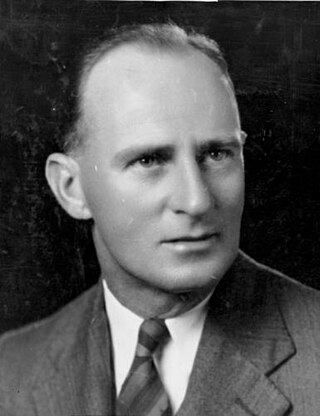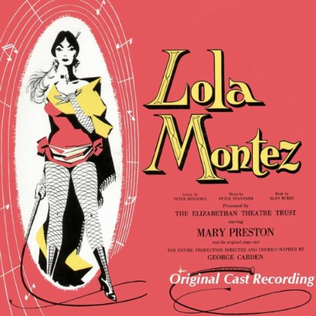Related Research Articles
The Shifting Heart is a play written in 1957 in Australia by Richard Beynon, it is an insight to the psychology of racism and its victims. In the background of 1950s Collingwood, Melbourne.
Caroline Chisolm is an Australian stage play by George Landen Dann. It debuted in 1939 as The Second Moses then was revised under its new title.

George Landen Dann was an Australian playwright, writer, and draftsman. He is best known for a number of award-winning and critically acclaimed plays such as In Beauty It Is Finished, Fountains Beyond, Caroline Chisholm and The Orange Grove. Dann wrote dozens of published and unpublished plays over the course of his lifetime. Originally writing plays for the amateur dramatic society at Sandgate, Queensland, Dann was a particularly shy and reclusive person, and even though he wrote part-time, his more popular plays were widely performed by amateur theatre companies around Australia. George Landen Dann's writing has been appreciated for its social realism, with a number of his plays delving into issues involving Indigenous Australians and their central characters reflecting individuals that Dann had met during his time in outback Australia.
The Passionate Pianist is an Australian television film, or rather a live one-off television play, which aired in 1957 on ABC. This was part of ABC's twice monthly presentations of live plays during the late-1950s.

Blue Murder is an Australian live television play which aired in 1959 on ABC. Broadcast live in Sydney on 2 December 1959, a kinescope ("telerecording") was made of the broadcast so it could be shown in Melbourne.

Close to the Roof is a 1960 Australian live television play which aired on ABC. Broadcast 14 December 1960 in Sydney, it was kinescoped ("telerecorded") and shown in Melbourne on 25 January 1961. Australian TV drama was relatively rare at the time.
Night of the Ding-Dong is a 1954 stage play by Ralph Peterson. It was this second play, following The Square Ring. It is a comedy set in Adelaide just after the Crimean War about the locals fearing a Russian invasion. It is based on a real incident.
"A Time to Speak" is a 1965 Australian television film that aired on ABC. This period drama, set around 1900, was written by Noel Robinson. It was the third production to air within a three- week period. The film premiered on 7 April 1965, in Sydney and Melbourne.
"Campaign for One" is a 1965 Australian television film. A remake of an episode of the BBC series Wednesday Play, it aired in a 60-minute time-slot on ABC on 24 November 1965 in Melbourne, Sydney, and on 5 January 1966 in Brisbane. as part of Wednesday Theatre.
Phillip Grenville Mann was an Australian actor, playwright, stage director and manager, and writer.
"A Season in Hell" is a 1964 Australian TV movie broadcast on the ABC which originally aired as an episode of Wednesday Theatre. It was directed by Henri Safran from a script by Patricia Hooker and was shot at the ABC's Gore Hill Studios in Sydney. "A Season in Hell" aired on 1 April 1964 in Sydney, on 22 April 1964 in Brisbane, and on 29 April 1964 in Melbourne.
The Quiet Season is a 1965 Australian half-hour television play. It aired on the Australian Broadcasting Commission stations Australia-wide and was produced in the Toowong studios of the Brisbane, Queensland, station (ABQ).

Lola Montez is a 1958 Australian musical. It was written by Alan Burke, Peter Stannard, and Peter Benjamin and focuses on four days of Lola Montez visiting the Ballarat Goldfields.
"The Tower" is a 1964 TV play broadcast by the Australian Broadcasting Corporation. It aired on 2 December 1964 as a stand-alone in Melbourne and on 28 April 1965 as part of Wednesday Theatre in Sydney. It aired on 6 January 1965 in Brisbane. It was based on a play by Hal Porter and directed by Christopher Muir in the ABC's studios in Melbourne.
"Daphne Laureola" is a 1965 Australian television play based on Daphne Laureola by James Bridie. It screened as part of Wednesday Theatre.
Dark Brown is a 1963 Australian TV play. It was based on a British play that had been filmed by the ABC in 1957.
Vacancy in Vaughn Street is a 1963 Australian television short. It was the first television play produced in Brisbane. and aired on Australian Broadcasting Commission. The same team then made Dark Brown (1963).
The Absence of Mr Sugden is a 1965 Australian TV play. It was the fifth drama to be made at the ABC's Toowong studios and the second one in 1965. It was shot on 9 December 1965 using an all-male cast of six.
Arabesque for Atoms is a 1965 Australian television play shot in Brisbane.
Crisis is a 1963 Australian television play filmed in Brisbane made by the Christian Television Association. The cast included thirty volunteers from Sandcliffe Little Theatre and the Redcliff Music and Arts Society. Equipment was donanted by Brisbane General Hospital, the Red Cross and the Post Office.
References
- ↑ "WEDNESDAY". The Canberra Times . Vol. 39, no. 11, 074. Australian Capital Territory, Australia. 8 February 1965. p. 14. Retrieved 20 March 2017– via National Library of Australia.
- 1 2 3 "Oh those bells". TV Times. 4 November 1964. p. 12.
- ↑ "TODAYS TV". The Canberra Times . Vol. 39, no. 11, 076. Australian Capital Territory, Australia. 10 February 1965. p. 19. Retrieved 11 June 2016– via National Library of Australia.
- ↑ "TV Guide". Sydney Morning Herald. 8 February 1965. p. 13.
- ↑ "TV Guide". The Age. 24 June 1965. p. 26.
- 1 2 "Two Australian Plays from Brisbane TV". The Age. 24 June 1965. p. 11.
- ↑ "By George; George Landen Dann: Queensland theatre history; sunshine coast; LaBoite Theatre".
- ↑ "Australian Comedy on Television". Sydney Morning Herald. 11 February 1965. p. 10.